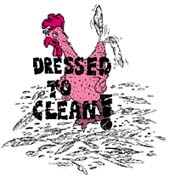For that feather touch
 poultry just discovered a new feather in its cap: that it can help make this polluted world a little cleaner. It came as a pleasant surprise when us-based scientists recently announced that chicken feather can help clean up those ugly oil slicks quickly, efficiently and - most important of all these factors - cheaply. So don't be surprised if, someday soon enough, you find chicken feather-padded nappies and mops, now that the agricultural scientists have devised ingenious ways to turns these into absorbent or filler materials.
poultry just discovered a new feather in its cap: that it can help make this polluted world a little cleaner. It came as a pleasant surprise when us-based scientists recently announced that chicken feather can help clean up those ugly oil slicks quickly, efficiently and - most important of all these factors - cheaply. So don't be surprised if, someday soon enough, you find chicken feather-padded nappies and mops, now that the agricultural scientists have devised ingenious ways to turns these into absorbent or filler materials.
Whether its soaking up oil spills, "sponging" heavy metals out of industrial effluents or filtering soot from air, chicken feathers do their job most efficiently, claim Walter Schmidt and his research team at the us department of agriculture's Agricultural Research Service in Beltsville, Maryland.The feathers can also be useful as a cheap filler for plastics, Schmidt says (New Scientist, Vol 158, No 2129).
At the current rate, the two million tonnes of chicken feather that America produces every year can be of immense value and use to the environment.
Right now, these feathers are sometimes autocalved to produce a low-value feedstuff for poultry and cattle, but other than this, there is very little profit to be made from processing chicken feathers.
However, Schmidt and his team at Beltsville plan to change this soon. They have developed a cheap mechanical method for separating the barbs of the feather from the central shaft, or the quill.
Both contain keratin, the supertough polymer found in hair, fingernails and wool. However, the crystal structure of the keratin in the quills of chicken feather differs from that found in barbs. And though daintier, the barb keratin fibres are much stronger than those found in the quill and therefore, find a broader range of applications.
These barb keratin fibres, more importantly, are extremely absorbent because they are so fine, with their average diameter being only six micrometres. Compared to this, woodpulp (diameter: 20 micrometers) and wool (30 micrometres) appear exceedingly thick. "These feather fibres are much finer which means that you get much more absorption per unit of weight," explains Schmidt.
Feathers emerge from poultry farms in water, so they have to be dried and treated with ethanol so that they are properly disinfected.
Shredding comes next after which, the barbs are separated from the quills. The separation device is a vertical cylinder running half the length of a larger, concentric outer cylinder. The mixture of feather fragments is sucked down through the central channel. Turbulent air flow at the exit point makes the circular chunks of quill plummet to the bottom of the larger tube, where they are drawn off. The barb fibres, meanwhile, float back to the top where they are sucked out.
Schmidt has already conducted several tests to confirm the absorbent qualities of the barb fibres in several applications. In nappies, for instance, these fibres can be over 20 per cent lighter while retaining absorbent qualities comparable to conventional nappy material.
The feathers will also be effective in cleaning up oil slicks, Schmidt says. The team has already shown how effectively these fibres absorb heavy metals such as chromium and copper from water reserves and has also tested them as a filler material for plastic, such as polyurethane.
The Agricultural Research Service has recently announced that it hopes to test the manufacturing system in a pilot plant within the coming year.
